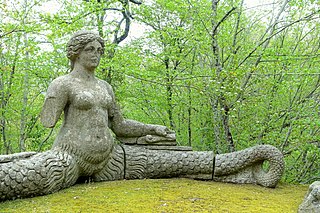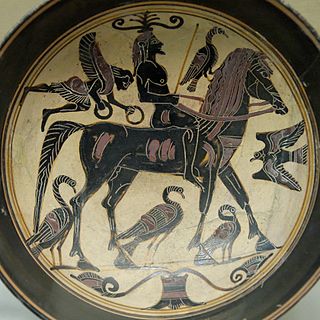Related Research Articles

Aristophanes was an Ancient Greek comic playwright from Athens and a poet of Old Attic Comedy. He wrote in total forty plays, of which eleven survive virtually complete today. These provide the most valuable examples of a genre of comic drama known as Old Comedy and are used to define it, along with fragments from dozens of lost plays by Aristophanes and his contemporaries.

In Greek mythology, Eris is the goddess and personification of strife and discord, particularly in war, and in the Iliad. According to Hesiod she was the daughter of primordial Nyx (Night), and the mother of a long list of undesirable personified abstractions, such as Ponos (Toil), Limos (Famine), Algae (Pains) and Ate (Delusion). Eris initiated a quarrel between Hera, Athena and Aphrodite, which led to the Judgement of Paris and ultimately the Trojan War. Eris's Roman equivalent is Discordia. According to Hesiod, there was another Eris, separate and distinct from Eris the daughter of Nyx, who was beneficial to men.

A nymph is a minor female nature deity in ancient Greek folklore. Distinct from other Greek goddesses, nymphs are generally regarded as personifications of nature; they are typically tied to a specific place, landform, or tree, and are usually depicted as maidens. Because of their association with springs, they were often seen as having healing properties; other divine powers of the nymphs included divination and shapeshifting. Nymphs, like other goddesses, were immortal except for the Hamadryads, whose lives were bound to a specific tree.

The Trojan War was a legendary conflict in Greek mythology that took place around the 12th or 13th century BC. The war was waged by the Achaeans (Greeks) against the city of Troy after Paris of Troy took Helen from her husband Menelaus, king of Sparta. The war is one of the most important events in Greek mythology, and it has been narrated through many works of Greek literature, most notably Homer's Iliad. The core of the Iliad describes a period of four days and two nights in the tenth year of the decade-long siege of Troy; the Odyssey describes the journey home of Odysseus, one of the war's heroes. Other parts of the war are described in a cycle of epic poems, which have survived through fragments. Episodes from the war provided material for Greek tragedy and other works of Greek literature, and for Roman poets including Virgil and Ovid.

In Greek mythology, Telephus was the son of Heracles and Auge, who was the daughter of king Aleus of Tegea. He was adopted by Teuthras, the king of Mysia, in Asia Minor, whom he succeeded as king. Telephus was wounded by Achilles when the Achaeans came to his kingdom on their way to sack Troy and bring Helen back to Sparta, and later healed by Achilles. He was the father of Eurypylus, who fought alongside the Trojans against the Greeks in the Trojan War. Telephus' story was popular in ancient Greek and Roman iconography and tragedy. Telephus' name and mythology were possibly derived from the Hittite god Telepinu.
In Greek mythology, Creusa may refer to the following figures:

In Greek mythology and religion, Themis is the goddess and personification of justice, divine order, law, and custom. She is one of the twelve Titan children of Gaia and Uranus, and the second wife of Zeus. She is associated with oracles and prophecies, including the Oracle of Delphi. Her symbol is the Scales of Justice.
In Greek mythology, Enyo is a war-goddess, frequently associated with the war-god Ares. The Romans identified her with Bellona.

In Greek mythology, Echidna was a monster, half-woman and half-snake, who lived alone in a cave. She was the mate of the fearsome monster Typhon and was the mother of many of the most famous monsters of Greek myth.

In Greek mythology, the Horae, Horai or Hours were the goddesses of the seasons and the natural portions of time.
In Greek mythology, Hipponous referred to several people:

The Knights was the fourth play written by Aristophanes, who is considered the master of Old Comedy. The play is a satire on the social and political life of classical Athens during the Peloponnesian War, and in this respect it is typical of all the dramatist's early plays. It is unique, however, in the relatively small number of its characters, and this was due to its vitriolic preoccupation with one man, the pro-war populist Cleon. Cleon had prosecuted Aristophanes for slandering the polis with an earlier play, The Babylonians, for which the young dramatist had promised revenge in The Acharnians, and it was in The Knights that his revenge was exacted. The Knights won first prize at the Lenaia festival when it was produced in 424 BC.

The Birds is a comedy by the Ancient Greek playwright Aristophanes. It was performed in 414 BC at the City Dionysia in Athens where it won second place. It has been acclaimed by modern critics as a perfectly realized fantasy remarkable for its mimicry of birds and for the gaiety of its songs. Unlike the author's other early plays, it includes no direct mention of the Peloponnesian War and there are few references to Athenian politics, and yet it was staged not long after the commencement of the Sicilian Expedition, an ambitious military campaign that greatly increased Athenian commitment to the war effort. In spite of that, the play has many indirect references to Athenian political and social life. It is the longest of Aristophanes's surviving plays and yet it is a fairly conventional example of Old Comedy.
The Acharnians or Acharnians is the third play — and the earliest of the eleven surviving plays — by the Athenian playwright Aristophanes. It was produced in 425 BC on behalf of the young dramatist by an associate, Callistratus, and it won first place at the Lenaia festival.

Old Comedy is the first period of the ancient Greek comedy, according to the canonical division by the Alexandrian grammarians. The most important Old Comic playwright is Aristophanes – whose works, with their daring political commentary and abundance of sexual innuendo, de facto define the genre. The only extant plays of Old Comedy are credited to Aristophanes. There are only fragments and 'testimonia' of all other Old Comedy playwrights and plays.

Alala was the personification of the war cry in Greek mythology. Her name derives from the onomatopoeic Greek word ἀλαλή (alalḗ), hence the verb ἀλαλάζω (alalázō), "to raise the war-cry". Greek soldiers attacked the enemy with this cry in order to cause panic in their lines and it was asserted that Athenians adopted it to emulate the cry of the owl, the bird of their patron goddess Athena.
In Greek mythology, Kydoimos or Cydoemus was the personification of the din of battle, confusion, uproar and hubbub. He was probably numbered amongst the Makhai, daimones of the battlefield. Kydoimos appears in Aristophanes' Peace as a character.
In Greek mythology, the Phonoi are collectively the personification of murder. In Hesiod's Theogony, the Phonoi are listed among the children of Eris (Strife). The Phonoi are named in line 228 of the Theogony, which lists four personified plural abstractions, the Hysminai (Combats), the Machai (Battles), the Phonoi (Murders), and the Androktasiai (Slaughters), as being among the offspring of Eris (Strife):
In Greek mythology, the Hysminai or Hysminae are collectively the personification of combat. In Hesiod's Theogony, the Hysminai are listed among the children of Eris (Strife). Like all of the children of Eris given by Hesiod, the Hysminai are a personified abstraction, allegorizing the meaning of their name, and representing one of the many harmful things which might be thought to result from discord and strife, with no other identity.

In Greek mythology, Eurypylus ("Broadgate") was the son of Telephus, king of Mysia. He was a great warrior, who led a Mysian contingent that fought alongside the Trojans against the Greeks in the Trojan War. He killed Machaon, and was himself killed by Achilles' son Neoptolemus.
References
- ↑ Niall W. Slater, Spectator Politics: Metatheatre and Performance in Aristophanes (University of Pennsylvania Press, 2002), p. 119.
- ↑ William Kendrick Pritchett, The Greek State at War (University of California Press, 1979), vol. 3, p. 161.
- ↑ Pindar, Dithyrambs fragment 78.
- ↑ Quintus Smyrnaeus, Fall of Troy 8. 424 ff
- ↑ "War and His Bride". mythfolklore.net. Archived from the original on 2019-08-10. Retrieved 2024-08-25.
- ↑ Loeb Classics Library, Babrius I.70 Archived 2017-02-23 at the Wayback Machine
- ↑ Richard F. Moorton, Jr., "Dionysus or Polemos? The Double Message of Aristophanes' Acharnians," in The Eye Expanded: Life and the Arts in Greco-Roman Antiquity (University of California Press, 1999), pp. 24, 39, 42, 45.
- ↑ Carroll Moulton, Aristophanic poetry, Göttingen 1981, p. 87 Archived 2024-08-25 at the Wayback Machine
- ↑ Carlo Ferdinando Russo, Aristophanes: An Author for the Stage (Routledge, 1962, 1994), pp. 135, 139, 143, 145; Slater, Spectator Politics, pp. 120, 280.
- ↑ Daniel Chapelle, Nietzsche and Psychoanalysis (State University of New York Press, 1993), p. 53, citing NER 19, frg. 53.
- ↑ Gregory Fried, Heidegger's Polemos: From Being to Politics (Yale University Press, 2000), p. 21.
- ↑ Fried, Heidegger's Polemos, p. 23.
- ↑ Fried, Heidegger's Polemos, p. 17.